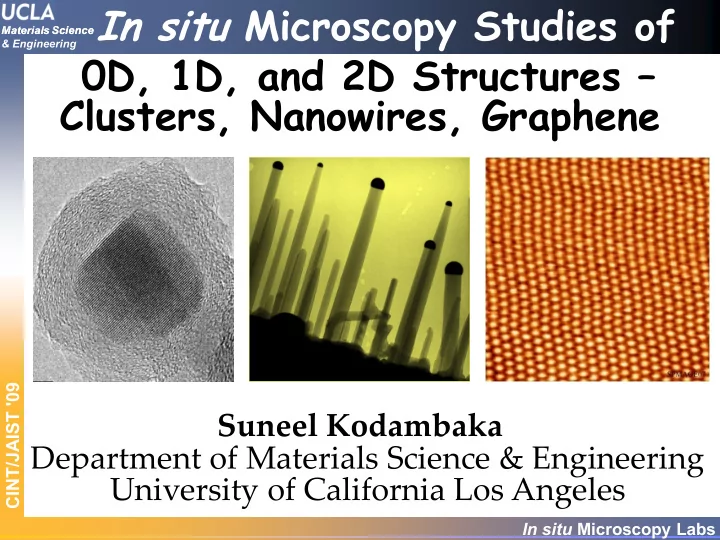

In situ Microscopy Studies of Materials Science Materials Science & Engineering 0D, 1D, and 2D Structures – Clusters, Nanowires, Graphene CINT/JAIST '09 Suneel Kodambaka Department of Materials Science & Engineering University of California Los Angeles In situ Microscopy Labs
Materials Science Materials Science & Engineering 3. Growth of Semiconducting Graphene on Pd(111) A B Questions we'd like to address: 1.How does graphene form? X O X' 2.What is the role of substrate? Potentially transformative 10 nm 40 nm Can be tailor the C D Pd[110] electronic properties of 0.20 Gr[2110] height (Å) epitaxial graphene 0.15 CINT/JAIST '09 & 0.10 grow "device-ready" 0.05 layers on Si wafers? 0 50 100 150 200 X O X' distance (Å) 22 Å
Graphene/Pd(111): Materials Science Materials Science & Engineering tunneling bias-dependent image contrast I = 0.24 nA I = 0.24 nA V T = +1.1 V = +1.1 V V T = = -1.1 V 1.1 V CINT/JAIST '09
STS of Graphene/Pd(111) Materials Science Materials Science & Engineering 7 10 STM 0.25 eV 8 LDOS 6 6 4 5 (dI/dV) / (I/V) 2 4 0 -2.0 -1.5 -1.0 -0.5 0.0 0.5 1.0 1.5 2.0 3 16 DFT 0.3 eV 14 2 12 PDOS 10 8 1 8.3 nm 6 4 0 2 -2 -1 0 1 2 0 V (V) -6 -4 -2 0 2 4 6 0.25eV E (eV) 2 band gap of 0.2-0.3 eV! (dI/dV)/(I/V) 1 CINT/JAIST '09 0 -0.4 -0.2 0.0 0.2 0.4 Substrate can greatly influence graphene properties
Materials Science Materials Science & Engineering 2. Nucleation and Growth Kinetics of Si and Ge nanowires J. Tersoff, M.C. Reuter, and F.M. Ross IBM T. J. Watson Research Center, Yorktown Heights B.-J. Kim, C.-Y. Wen, and E.A. Stach Dept. Materials Science and Engineering, Purdue University Questions we'd like to address: 1.How do nanowires grow? 2.What is the role of catalyst composition? Potentially transformative CINT/JAIST '09 Can be fabricate nanowire heterostructures with atomically abrupt interfaces, tunable shapes & structures? Partially funded by UC Discovery, UCEI, & Northrop Grumman Space Technology In situ Microscopy Labs
Si wire nucleation kinetics Materials Science Materials Science & Engineering T = 525 o C; Si 2 H 6 = 8 10 -7 Torr t = 0, vacuum CINT/JAIST '09 Crystalline Au + Si 2 H 6 → liquid AuSi droplets → Si nw/AuSi
Si wire nucleation kinetics Materials Science Materials Science & Engineering 6 Si 2 H 6 : 4 10 -6 Torr 5 T = 525 o C r (nm) Rapid initial growth t=226 s crossover C 4 to slow growth 3 500 600 700 800 t=233 s t (sec) 3 d r P r dt k c c k t t k VL 1 LS LS 1 0 R R CINT/JAIST '09 Critical supersaturation of Si in AuSi droplets t=390 s B.J. Kim, J. Tersoff, S. Kodambaka, M.C. Reuter, E.A. Stach, & F.M. Ross, Science 322 , 1070 (2008).
Ge wire growth vs. Ge 2 H 6 flux Materials Science Materials Science & Engineering T = 410 o C 90 nm CINT/JAIST '09 Ge nanowire morphology can be t movie : 30x t expt controllably manipulated with wire diameter: 25 nm deposition pressures
Materials Science Materials Science & Engineering 1. Thermal/Chemical Stability of Small Clusters Questions we'd like to address: 1.How do hollow core structures form? 2.What is the role of surface/interface structure & orientation? 3.What controls their stability? Potentially transformative Can be make better & CINT/JAIST '09 cheaper catalysts? Funded by ACS-PRF 48108-G10 & Hitachi Labs In situ Microscopy Labs
Ostwald ripening of the titania cores Materials Science Materials Science & Engineering T = 850ºC 10 s 236 s 241 s Larger TiO 2 core grows at the expense of smaller one resulting in hollow graphitic shells CINT/JAIST '09 1022 s 1023 s 1024 s 900 s At longer times, only hollow cores remain.
Ultra- Ultra -High Vacuum Variable High Vacuum Variable- -Pressure Pressure Materials Science Materials Science & Engineering Scanning Electron Microscope Scanning Electron Microscope In situ SEM studies of: * Nanowire nucleation & growth kinetics * Liquid droplet/solid surface dynamics * Chemical & thermal stabilities of nanostructures UHV-CVD in a SEM: Operating pressure: 10 -7 – 1 mTorr Temperatures: 300 - 1250 K CINT/JAIST '09 Imaging modes: SE, BSE, STEM Funded by Dept. Materials Science & School of Engineering at UCLA
Recommend
More recommend